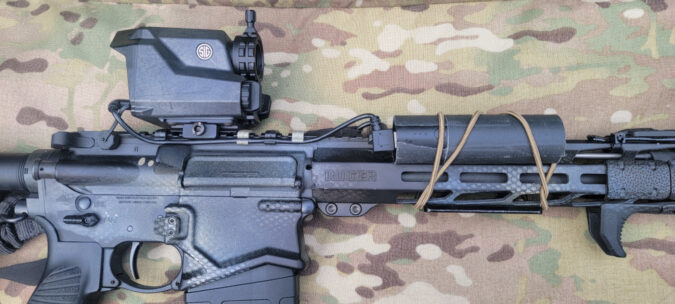If you don’t live in the southern US, you may not be aware of the feral hog problem that exists in large swaths of rural land here and even extends into some suburban areas.
I’ve spent the last few years chasing feral pigs around various farms in the southeast, and as a result, I have become a bit of a nerd when it comes to night vision systems and IR. When I got the chance to run the SIG Sauer Echo 3 thermal for a few months to supplement my existing night vision-based hog hunting gear, I jumped on it.
Passive and active infrared (IR) tools like night vision goggles, IR lasers, and IR illuminators are highly adaptable to different tasks. I can drive a car, run up and down stairs, do detail tasks like fixing trail cameras, and a world of other things while wearing dual tube NVGs, especially paired with an appropriately mounted illuminator.
They do leave a little to be desired when looking for hogs on a wide open field, especially since hogs have an annoying trait of absorbing IR light. Thermal, on the other hand, might as well be a cheat code for finding and shooting feral pork on the hoof. In my experience, pairing the two together is a recipe for success, and I’ve found the SIG Sauer Echo 3 has some specific features that lend itself to such a pairing.
SPECS
| Manufacturer | SIG Sauer |
|---|---|
| Product Line | Echo3 |
| Magnification | 2-12x |
| Reticle | Multiple |
| OLD | 40mm |
| Length | 4.3″ |
| Width | 2.6″ |
| Height | 3.3″ |
| Weight | 14.3 oz |
| Waterproofing | IPX4 |
| Power Source | CR123 |
| Runtime | 6 Hours |
| Finish | Black |
| Illumination Settings | 8 Color palettes & 6 Brightness settings |
HUNTING HOGS
Most commercial standalone thermal optics on the market tend to be arranged like a traditional riflescope. They have a rear lens between your eyeball and the display, which means they also have an eye relief similar to a traditional optic. Your head and eye need to be in a relatively small area behind the optic to use it effectively.
The Echo differs from those optics by simply presenting you with an unobstructed view of the display itself on the back of the housing – no eyepiece, no lens. Not only does this reduce the overall size of the optic, it also means there’s no eye relief. As long as you can see the display, you can use the thermal.
Additionally, the compact size of the Echo means I could mount the sight in the middle of my Ruger SFAR’s upper receiver rail and still have ample clearance behind the optic for my NVGs riding on my helmet, and the relatively lightweight helped keep my hunting rifle handy when walking back and forth across a large field in the dark.
When paired with helmet-mounted night vision in this way, you can adjust your NVG mount to allow you to look under your night vision to shoot with the thermal while still being able to see through your night vision above the thermal and even allows an essentially instant transition from using the thermal to shooting with an IR laser and the NVGs without having to flip the night vision up and down.
DOWNSIDES?
This brings me to one of the downsides of the Echo – field of view. The Echo only has a 10-degree field of view, and when you’re shooting hogs on the run inside of 100 yards, this can be problematic even at 1x.
Comparably priced thermals from other brands can have anywhere from a 13-degree field of view to over 30 degrees claimed field of view, and a PVS-14 night vision unit typically has a 40-degree field of view. As a result of this narrow field of view, it’s very easy to lose track of one or more hogs when they start to do their 3 Stooges impersonation after the first shot goes off, which is why I often transition to NVGs for follow-up shots.

With traditional thermals with eye relief, you’ll often have to flip your NV up out of the way to get behind the optic, making a transition back to NVGs almost impossible to do in a timely manner.
I have run a single PVS-14 over my off-side eye before for this situation, but I found the PVS-14 was often bumping into the side of the rifle optic when set up this way. The compact size and direct view screen of the Echo mitigates these issues, though, and allows for a much more seamless experience switching between the two.
Another downside I have found is the Echo’s resolution. The thermal sensor is listed as 320×240, which once again lags behind comparably priced thermal systems. I found that once I was beyond 200 yards, I would often have to wait for movement or stalk in closer before I could be sure that a heat signature was a hog and not a deer laying down with its head down.
More than once I’d start stalking in on what I thought was a lone boar at several hundred yards only to see the long neck of a deer poke up to prove otherwise. However, I also generally try to take shots from no further than 100 yards, and oftentimes closer, which has effectively mitigated the issues with resolution on game at the longer distances.
By the time I start approaching a firing position, the resolution is adequate enough to pick out the snout, ears, and body details of a hog for positive identification.

While these are downsides to the Echo, it still has quite a few redeeming features. In addition to the usual variety of fixed reticles, the Echo also utilizes the SIG BDX system. You can program customized reticles based on the ballistic performance of your given rifle and ammo, as well as pair the Echo with a BDX-enabled laser rangefinder for custom solutions on the fly in the field.
Personally, I never found myself in a situation where I felt I could make use of this last feature, but that is largely driven by my preferred spot-and-stalk hunting style while working across large fields.
The Echo also features the ability to capture photos and video through the optic, as well as a recoil-activated video mode. The recoil-based capture only gives you a 60-second window to shoot after triggering it, though, and when I could actually remember to use it I found that it would break the video up into small files that had to be recombined later for a seamless video.
Additionally, I discovered that whatever brightness I had the display set to was reflected in recorded images and video. Since I generally had the screen turned all the way down when in the field hunting hogs, anything I recorded also came out very dark.
The Echo also has app functionality for uploading ballistic profiles for custom reticles, viewing and saving captured videos and images, as well as real time viewing of the optic from another device. The app connectivity also allows for firmware updates to the Echo, which is a nice touch by SIG.
I did run into issues getting the sight to connect to my Samsung S21 Ultra phone, but had no such issues with an S20, S24 Ultra, or inexpensive Samsung tablet, so I am chalking that up to some kind of problem with the phone itself and not a knock against the optic.

Finally, an undocumented feature is that the Echo does indeed work with external USB battery banks via a USB Mini-B type cable. I have no idea why SIG chose the much older Mini-B plug standard for the optic over the much more common Micro-B or the current USB-C standard, but the appropriate cables are still relatively easy to source from places like Amazon.
Using a 10,000 mAh USB battery bank, I was able to get several hours of use out of the Echo while leaving the CR123 batteries installed as a backup. The Echo will also seamlessly swap between internal and external power, so there’s no issues with initially forgetting to turn on the external battery pack or if the pack runs out of power in the middle of a hunt.
LOOSE ROUNDS
Overall, the SIG Echo isn’t perfect – but in this price range, nothing is. Frankly, if a thermal rifle optic is going to be your only night hunting optic then you may want to look at something with a little more magnification and a little better resolution.
However, if you are planning to run a mix of helmet mounted night vision and a rifle-mounted thermal so you can use the NV for navigation, watching for snakes, coordinating with other shooters using IR lasers, etc then the Echo has a lot of merit as a complimentary thermal on your rifle.
For my needs, I am a fan. The pigs I’ve left laying in a field with it weren’t too impressed, however.

NEXT STEP: Download Your Free Target Pack from RECOIL
For years, RECOIL magazine has treated its readers to a full-size (sometimes full color!) shooting target tucked into each big issue. Now we’ve compiled over 50 of our most popular targets into this one digital PDF download. From handgun drills to AR-15 practice, these 50+ targets have you covered. Print off as many as you like (ammo not included).
Get your pack of 50 Print-at-Home targets when you subscribe to the RECOIL email newsletter. We’ll send you weekly updates on guns, gear, industry news, and special offers from leading manufacturers – your guide to the firearms lifestyle.
You want this. Trust Us.
Read the full article here

![SIG Echo 3 Thermal: A Thermal Companion For NVG Users [REVIEW] SIG Echo 3 Thermal: A Thermal Companion For NVG Users [REVIEW]](https://gundayfunday.com/wp-content/uploads/2024/09/SIG-Echo-3-5.jpg)



![Best 10mm 1911 Pistols [Field Tested] Best 10mm 1911 Pistols [Field Tested]](https://gundayfunday.com/wp-content/uploads/2024/12/10mm-1911-feature-colt-delta-elite-390x220.jpg)